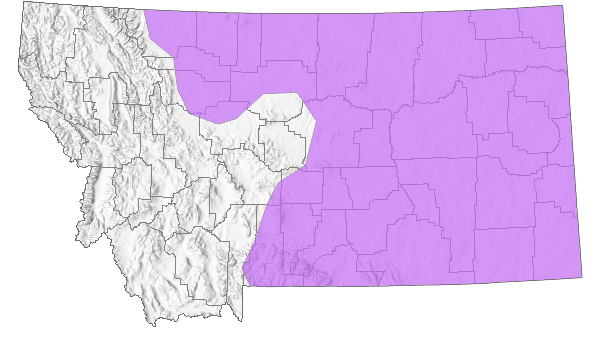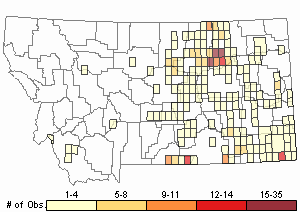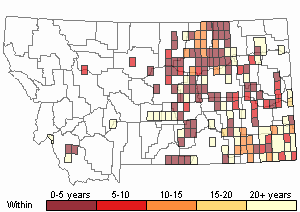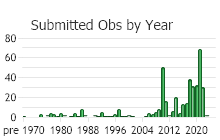View in other NatureServe Network Field Guides
NatureServe
Montana
Utah
Wyoming
Idaho
Wisconsin
British Columbia
South Carolina
Yukon
California
New York
Small-flowered Buckwheat - Eriogonum pauciflorum
Other Names:
Eriogonum multiceps
Native Species
Global Rank:
G5
State Rank:
S4
(see State Rank Reason below)
C-value:
Agency Status
USFWS:
USFS:
BLM:
External Links
State Rank Reason (see State Rank above)
Eriogonum pauciflorum occurs through most of central and eastern Montana. The locations of older and relatively newer observations does not suggest a change in the plant's Montana distribution. Populations can be common. Threats have not been identified. A continuation of current information on locations, population sizes, and threats is needed.
- Details on Status Ranking and Review
Range Extent
ScoreF - 20,000-200,000 sq km (~8,000-80,000 sq mi)
Comment183,107 square kilometers
Area of Occupancy
ScoreF - 126-500 4-km2 grid cells
CommentPlant occurs in 227 of the 30,590 4x4 square-kilometer grid cells that cover Montana.
Number of Populations
ScoreD - 81 - 300
Comment267 observations
Number of Occurrences or Percent Area with Good Viability / Ecological Integrity
ScoreD - Some (13-40) occurrences with excellent or good viability or ecological integrity
Comment37 observations assumed to be of good viability based on comments of 'common' or on counts with at least 100 plants.
Environmental Specificity
ScoreD - Broad. Generalist or community with all key requirements common
CommentBarren, rocky, sandy, or fine-textured soils in badlands and grasslands.
Threats
ScoreD - Low
General Description
PLANTS: Mat-forming, herbaceous, perennial forb that grows from a branched caudex. Plants are short with ascending flowering stems, 4-20 cm tall. Foliage is gray from soft-matted hairs (tomentose)
LEAVES: All basal with long petioles and some persisting dead leaves (marcescent). Blades are oblanceolate to spatulate in shape, 1-3 cm long, and greyish from the tomentose hairs on both surfaces.
INFLORESCENCE: Capitate (head-like cluster of flowers atop a stem (scape) which lacks leaves or any branching). Consists of 2-5 (7) involucres which hold the individual flowers and are subtended by 2-6 linear to lanceolate leaf-like bracts. The 5 involucral bracts are erect, tomentose, and 3-5 mm long. Flowers are 1-3 mm long. Petals and sepals are undifferentiated (tepals), white- or rose-colored, oblong in shape, fused (connate) at their lower third, and pubescent. Stamens are exserted beyond the tepals and have long-loose hairs along the filaments.
Sources: Reveal in FNA 2005; Lesica et al. 2012.
Species Range
Montana Range
Range Descriptions

 Native
Native
Range Comments
Saskatchewan and Manitoba south to Colorado and Nebraska (Lesica et al. 2012).
Observations in Montana Natural Heritage Program Database
Number of Observations: 571
(Click on the following maps and charts to see full sized version)
Map Help and Descriptions
Relative Density

Recency



 (Observations spanning multiple months or years are excluded from time charts)
(Observations spanning multiple months or years are excluded from time charts)
Habitat
Barren, rocky, sandy or fine-textured soil of badlands, steep slopes, and ridge crests in the plains and valleys of Montana (Lesica et al. 2012).
National Vegetation Classification System Groups Associated with this Species
Sparse and Barren
Sparse and Barren
Ecology
INVERTEBRATE-PLANT INTERACTIONSThe northern population of the Mormon Metalmark
(Apodemia mormo) Butterfly occurs in the prairies of Saskatchewan, Canada and along the Milk and Missouri Rivers and their tributaries in the United States, but is disjunct (geographically separate) from the main distribution in the southwestern USA (Opler 1999; Pruss et al. 2008). Throughout its range this butterfly uses several species of
Eriogonum (Wick 2013). In Saskatchewan Mormon Metalmark uses the Small-flowered Buckwheat (
Eriogonum pauciflorum) as an obligatory food plant (i.e., host plant) for larvae and as a primary nectar source for adults (Pruss et al. 2008). Rubber Rabbitbrush (
Ericamerica nauseosa) is used as a secondary nectar source, although it is not always present where butterfly colonies occur (Wick 2013). Adult butterflies use Small-flowered Buckwheat, Rubber Rabbitbrush, and Creeping Juniper (
Juniperus horizontalis) plants, bare soil, and rocks for perching and mating (Wick 2013). Ashley Wick studied why the Mormon Metalmark Butterfly does not occur in many areas of Saskatchewan where the host plant, Small-flowered Buckwheat, is abundant (2013). Wick found that the female butterflies in the prairie population oviposit in small crevices in the soil and on rocks near Small-flowered Buckwheat, but not directly on the host plant as previously thought from studies of other populations (Wick et al. 2012). Thus, micro-habitat characteristics in addition to Small-flowered Buckwheat abundance interact to affect the butterfly’s distribution. Her study provided the first documentation of the oviposition of the Mormon Metalmark Butterfly in Canada and showed that this behavior diverges from that seen in other parts of the butterfly’s range (Wick 2013).
POLLINATORS The following animal species have been reported as pollinators of this plant species or its genus where their geographic ranges overlap:
Bombus bifarius,
Bombus centralis,
Bombus flavifrons,
Bombus huntii,
Bombus melanopygus,
Bombus mixtus,
Bombus ternarius,
Bombus occidentalis,
Bombus insularis, and
Bombus flavidus (Thorp et al. 1983, Koch et al. 2012, Williams et al. 2014).
Management
A recovery strategy was developed for the Mormon Metalmark Butterfly's Prairie Population in Canada (Pruss et al. 2008). This recovery strategy provides background information, recovery goals, and recommended approaches to promoting the recovery of the butterfly, its habitat requirements, and conservation efforts for other species that are part of its habitat, such as the Small-flowered Buckwheat (Eriogonum pauciflorum).
Stewardship Responsibility
References
- Literature Cited AboveLegend:
 View Online Publication
View Online Publication Flora of North America Editorial Committee. 2005. Flora of North America North of Mexico. Volume 5. Magnoliophyta: Caryophyllidae: Caryophyllales, Polygonales, and Plumbaginales. New York, NY: Oxford Univ. Press. vii + 656 pp.
Flora of North America Editorial Committee. 2005. Flora of North America North of Mexico. Volume 5. Magnoliophyta: Caryophyllidae: Caryophyllales, Polygonales, and Plumbaginales. New York, NY: Oxford Univ. Press. vii + 656 pp. Koch, J., J. Strange, and P. Williams. 2012. Bumble bees of the western United States. Washington, DC: USDA Forest Service, Pollinator Partnership. 143 p.
Koch, J., J. Strange, and P. Williams. 2012. Bumble bees of the western United States. Washington, DC: USDA Forest Service, Pollinator Partnership. 143 p. Lesica, P., M.T. Lavin, and P.F. Stickney. 2012. Manual of Montana Vascular Plants. Fort Worth, TX: BRIT Press. viii + 771 p.
Lesica, P., M.T. Lavin, and P.F. Stickney. 2012. Manual of Montana Vascular Plants. Fort Worth, TX: BRIT Press. viii + 771 p. Opler, P.A. and A.B. Wright. 1999. A field guide to western butterflies. Second edition. Peterson Field Guides. Houghton Mifflin Company, Boston, Massachusetts. 540 pp.
Opler, P.A. and A.B. Wright. 1999. A field guide to western butterflies. Second edition. Peterson Field Guides. Houghton Mifflin Company, Boston, Massachusetts. 540 pp. Pruss, S., A. Henderson, P. Fargey, and J. Tuckwell. 2008. Recovery Strategy for the Mormon Metalmark (Apodemia Mormo) Prairie Population, in Canada. Species at Risk Act Recovery Strategy Series. Parks Canada Agency. Ottawa. 29 pp.
Pruss, S., A. Henderson, P. Fargey, and J. Tuckwell. 2008. Recovery Strategy for the Mormon Metalmark (Apodemia Mormo) Prairie Population, in Canada. Species at Risk Act Recovery Strategy Series. Parks Canada Agency. Ottawa. 29 pp. Thorp, R.W., D.S. Horning, and L.L. Dunning. 1983. Bumble bees and cuckoo bumble bees of California (Hymenoptera: Apidae). Bulletin of the California Insect Survey 23:1-79.
Thorp, R.W., D.S. Horning, and L.L. Dunning. 1983. Bumble bees and cuckoo bumble bees of California (Hymenoptera: Apidae). Bulletin of the California Insect Survey 23:1-79. Wick, A., and J. Jamelle, S. Pruss, and N. Erbilgin. 2012. First observations of Mormon Metalmark (Apodemia mormo) oviposition behavior in Canada. Canadian Field-Naturalist. 126:34-37.
Wick, A., and J. Jamelle, S. Pruss, and N. Erbilgin. 2012. First observations of Mormon Metalmark (Apodemia mormo) oviposition behavior in Canada. Canadian Field-Naturalist. 126:34-37. Wick, Ashley Anne. 2013. Beyond the host plant: Multi-scale habitat models for a northern peripheral population of the butterfly, Apodemia mormo (Lepidoptera: Riodinidae). M.Sc. Thesis. University of Alberta. Edmonton, Alberta. 81p.
Wick, Ashley Anne. 2013. Beyond the host plant: Multi-scale habitat models for a northern peripheral population of the butterfly, Apodemia mormo (Lepidoptera: Riodinidae). M.Sc. Thesis. University of Alberta. Edmonton, Alberta. 81p. Williams, P., R. Thorp, L. Richardson, and S. Colla. 2014. Bumble Bees of North America. Princeton, NJ: Princeton University Press. 208 p.
Williams, P., R. Thorp, L. Richardson, and S. Colla. 2014. Bumble Bees of North America. Princeton, NJ: Princeton University Press. 208 p.
- Additional ReferencesLegend:
 View Online Publication
View Online Publication
Do you know of a citation we're missing? DuBois, K.L. 1979. An inventory of the avifauna in the Long Pines of Southeastern Montana. M.Sc. Thesis. Bozeman, MT: Montana State University. 113 p.
DuBois, K.L. 1979. An inventory of the avifauna in the Long Pines of Southeastern Montana. M.Sc. Thesis. Bozeman, MT: Montana State University. 113 p. Fritzen, D.E. 1995. Ecology and behavior of Mule Deer on the Rosebud Coal Mine, Montana. Ph.D. Dissertation. Bozeman, MT: Montana State University. 143 p.
Fritzen, D.E. 1995. Ecology and behavior of Mule Deer on the Rosebud Coal Mine, Montana. Ph.D. Dissertation. Bozeman, MT: Montana State University. 143 p. Harvey, S.J. 1990. Responses of steppe plants to gradients of water soil texture and disturbance in Montana, U.S.A. Ph.D. Thesis. Bozeman, MT: Montana State University. 34 p.
Harvey, S.J. 1990. Responses of steppe plants to gradients of water soil texture and disturbance in Montana, U.S.A. Ph.D. Thesis. Bozeman, MT: Montana State University. 34 p. Lesica, P., M.T. Lavin, and P.F. Stickney. 2022. Manual of Montana Vascular Plants, Second Edition. Fort Worth, TX: BRIT Press. viii + 779 p.
Lesica, P., M.T. Lavin, and P.F. Stickney. 2022. Manual of Montana Vascular Plants, Second Edition. Fort Worth, TX: BRIT Press. viii + 779 p. Owings, G.C. 2012. Patterns of gray rubber rabbitbrush occurrence in burned sagebrush-grasslands, Missouri River Breaks, Montana. M.Sc. Thesis. Bozeman, MT: Montana State University. 48 p.
Owings, G.C. 2012. Patterns of gray rubber rabbitbrush occurrence in burned sagebrush-grasslands, Missouri River Breaks, Montana. M.Sc. Thesis. Bozeman, MT: Montana State University. 48 p. Quire, R.L. 2013. The sagebrush steppe of Montana and southeastern Idaho shows evidence of high native plant diversity, stability, and resistance to the detrimental effects of nonnative plant species. M.Sc. Thesis. Bozeman, MT: Montana State University. 124 p.
Quire, R.L. 2013. The sagebrush steppe of Montana and southeastern Idaho shows evidence of high native plant diversity, stability, and resistance to the detrimental effects of nonnative plant species. M.Sc. Thesis. Bozeman, MT: Montana State University. 124 p. Seipel, T.F. 2006. Plant species diversity in the sagebrush steppe of Montana. M.Sc. Thesis. Bozeman, MT: Montana State University. 87 p.
Seipel, T.F. 2006. Plant species diversity in the sagebrush steppe of Montana. M.Sc. Thesis. Bozeman, MT: Montana State University. 87 p. Skinner, K.F. 1995. Plant and grasshopper community composition: indicators & interactions across three spatial scales. M.Sc. Thesis. Bozeman, MT: Montana State University. 144 p.
Skinner, K.F. 1995. Plant and grasshopper community composition: indicators & interactions across three spatial scales. M.Sc. Thesis. Bozeman, MT: Montana State University. 144 p. Tschache, O.P. 1970. Effects of ecological changes induced by various sagebrush control techniques on small mammal populations. M.Sc. Thesis. Bozeman, MT: Montana State University. 51 p.
Tschache, O.P. 1970. Effects of ecological changes induced by various sagebrush control techniques on small mammal populations. M.Sc. Thesis. Bozeman, MT: Montana State University. 51 p. Wick, A., S. Pruss, J. Spence, and N. Erbilgin. 2014. Microhabitat use in a northern peripheral population of Apodemia mormo: factors beyond the host plant. Journal of the Lepidopterists Society. 68:54-60.
Wick, A., S. Pruss, J. Spence, and N. Erbilgin. 2014. Microhabitat use in a northern peripheral population of Apodemia mormo: factors beyond the host plant. Journal of the Lepidopterists Society. 68:54-60. Wood, A.K. 1987. Ecology of a prairie mule deer population. Ph.D. Dissertation. Bozeman, MT: Montana State University. 205 p.
Wood, A.K. 1987. Ecology of a prairie mule deer population. Ph.D. Dissertation. Bozeman, MT: Montana State University. 205 p.
- Web Search Engines for Articles on "Small-flowered Buckwheat"





